在前边介绍Socket和ServerSocket连接交互的过程中,读写都是阻塞的。套接字写数据时,数据先写入操作系统的缓存中,形成TCP或UDP的负载,作为套接字传输到目标端,当缓存大小不足时,线程会阻塞。套接字读数据时,如果操作系统缓存没有接收到信息,则读线程阻塞。线程阻塞情况下,就不能处理其他事情。JDK1.4引入了通道和选择器的概念,以支持异步或多路复用的IO。
Unix系统中的select()方法可以实现异步IO,可以给该Selector注册多个描述符(可读或可写),然后对这些描述符进行监控。在Java中,描述符即为套接字Socket。
如JAVA I/O(二)文件NIO中对选择器的介绍,在非阻塞模式下,用select()方法检测发生变化的通道,每个通道都关联一个Socket,用一个线程实现多个客户端的请求,从而实现多路复用。
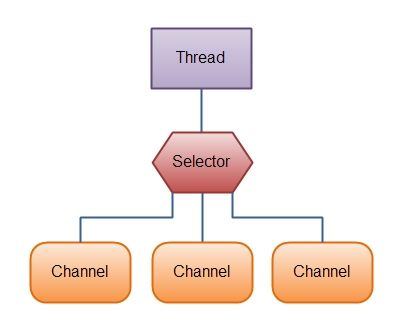
1. 简单实例
服务器端
import java.io.IOException; import java.net.InetSocketAddress; import java.nio.ByteBuffer; import java.nio.CharBuffer; import java.nio.channels.SelectionKey; import java.nio.channels.Selector; import java.nio.channels.ServerSocketChannel; import java.nio.channels.SocketChannel; import java.nio.charset.Charset; import java.util.Iterator; public class MultiJabberServer1 { public static final int PORT = 8080; public static void main(String[] args) throws IOException{ String encoding = System.getProperty("file.encoding"); Charset cs = Charset.forName(encoding); ByteBuffer buffer = ByteBuffer.allocate(16); SocketChannel ch = null;//Socket对应的channel //1.创建ServerSocketChannel ServerSocketChannel ssc = ServerSocketChannel.open(); //2.创建选择器Selector Selector sel = Selector.open(); try { //3.设置ServerSocketChannel通道为非阻塞 ssc.configureBlocking(false); //4.ServerSocketChannel关联Socket,用于监听连接,使用本地ip和port //注意:Socket也对通道进行了改造,直接调Socket.getChannel()将返回bull,除非通过下边与通道关联 //the expression (ssc.socket().getChannel() != null) is true ssc.socket().bind(new InetSocketAddress(PORT)); //5.将通道注册到Selector,感兴趣的事件为 连接 事件 ssc.register(sel, SelectionKey.OP_ACCEPT); System.out.println("Server on port: " + PORT); while(true) { //6.没有事件发生时,一直阻塞等待 sel.select(); //7.有事件发生时,获取Selector中所有SelectorKey(持有选择器与通道的关联关系)。 //由于基于操作系统的poll()方法,当有事件发生时,只返回事件个数,无法确定具体通道,故只能对所有注册的通道进行遍历。 Iterator<SelectionKey> it = sel.selectedKeys().iterator(); //8.遍历所有SelectorKey,处理事件 while(it.hasNext()) { SelectionKey sKey = it.next(); it.remove();//防止重复处理 //9.判断SelectorKey对应的channel发生的事件是否socket连接 if(sKey.isAcceptable()) { //10.与ServerSocket.accept()方法相似,接收到该通道套接字的连接,返回SocketChannel,与客户端进行交互 ch = ssc.accept(); System.out.println( "Accepted connection from:" + ch.socket()); //11.设置该SocketChannel为非阻塞模式 ch.configureBlocking(false); //12.将该通道注册到Selector中,感兴趣的事件为OP_READ(读) ch.register(sel, SelectionKey.OP_READ); }else { //13.发生非连接事件,此处为OP_READ事件。SelectorKey获取注册的SocketChannel,用于读写 ch = (SocketChannel)sKey.channel(); //14.将数据从channel读到ByteBuffer中 ch.read(buffer); CharBuffer cb = cs.decode((ByteBuffer)buffer.flip()); String response = cb.toString(); System.out.print("Echoing : " + response); //15.再将获取到的数据会写给客户端 ch.write((ByteBuffer)buffer.rewind()); if(response.indexOf("END") != -1) ch.close(); buffer.clear(); } } } } finally { if(ch != null) ch.close(); ssc.close(); sel.close(); } } }
如代码中注释标明,大致步骤包含:
- 创建ServerSocketChannel和Selector,设置通道非阻塞,并与服务端的Socket绑定
- 注册 ServerSocketChannel到Selector,感兴趣的事件为OP_CONNECT(获取连接)
- select()方法阻塞等待,直到有事件发生
- 遍历Selector中的所有注册事件,通过SelectorKey维护Selector和Channel关联关系
- 如果是连接事件,则调ServerSocketChannel.accept()方法获取SocketChannel,与客户端交互
- 如果是读事件,则通过SelectorKey中获取SocketChannel,读写数据
运行结果:
Server on port: 8080
客户端
import java.io.IOException; import java.net.InetAddress; import java.net.InetSocketAddress; import java.nio.ByteBuffer; import java.nio.channels.SelectionKey; import java.nio.channels.Selector; import java.nio.channels.SocketChannel; import java.nio.charset.Charset; import java.util.Iterator; import com.test.socketio.JabberServer; /** * 采用这种方式,读与写是非阻塞的 * 普通的读写是阻塞的,直到读完或写完 * */ public class JabberClient1 { static final int clPot = 8899; public static void main(String[] args) throws IOException{ //1.创建SocketChannel SocketChannel sc = SocketChannel.open(); //2.创建Selector Selector sel = Selector.open(); try { sc.configureBlocking(false); //3.关联SocketChannel和Socket,socket绑定到本机端口 sc.socket().bind(new InetSocketAddress(clPot)); //4.注册到Selector,感兴趣的事件为OP_CONNECT、OP_READ、OP_WRITE sc.register(sel, SelectionKey.OP_CONNECT | SelectionKey.OP_READ | SelectionKey.OP_WRITE); int i = 0; boolean written = false, done = false; String encoding = System.getProperty("file.encoding"); Charset cs = Charset.forName(encoding); ByteBuffer buffer = ByteBuffer.allocate(16); while(!done) { sel.select(); //5.从选择器中获取所有注册的通道信息(SelectionKey作为标识) Iterator<SelectionKey> it = sel.selectedKeys().iterator(); while(it.hasNext()) { SelectionKey key = it.next(); it.remove(); //6.获取通道,此处即为上边创建的channel sc = (SocketChannel)key.channel(); //7.判断SelectorKey对应的channel发生的事件是否socket连接,并且还没有连接 if(key.isConnectable() && !sc.isConnected()) { InetAddress addr = InetAddress.getByName(null); //连接addr和port对应的服务器 boolean success = sc.connect(new InetSocketAddress(addr, JabberServer.PORT)); if(!success) sc.finishConnect(); } //8.读与写是非阻塞的:客户端写一个信息到服务器,服务器发送一个信息到客户端,客户端再读 if(key.isReadable() && written) { if(sc.read((ByteBuffer)buffer.clear()) > 0) { written = false; String response = cs.decode((ByteBuffer)buffer.flip()).toString(); System.out.println(response); if(response.indexOf("END") != -1) done = true; } } if(key.isWritable() && !written) { if(i < 10) sc.write(ByteBuffer.wrap(new String("howdy " + i + " ").getBytes())); else if(i == 10){ sc.write(ByteBuffer.wrap("END".getBytes())); } written = true; i++; } } } } finally { sc.close(); sel.close(); } } }
客户端与服务端类似,不同之处:
- 创建SocketChannel通道,注册到选择器,刚兴趣的事件为OP_CONNECT、OP_READ、OP_WRITE
- 调试发现,客户端sel.select()不会阻塞,对注册通道不断的遍历,并且每次都可写。原因是OP_WRITE事件会持续生效,即只要连接存在就可以写,不管服务端是否有返回
- 本例中,客户端发送一条数据,服务端接收一条,并返回给客户端;客户端接到服务端的消息后,才会发生下一条数据,主要通过written标识进行控制的。
运行机制
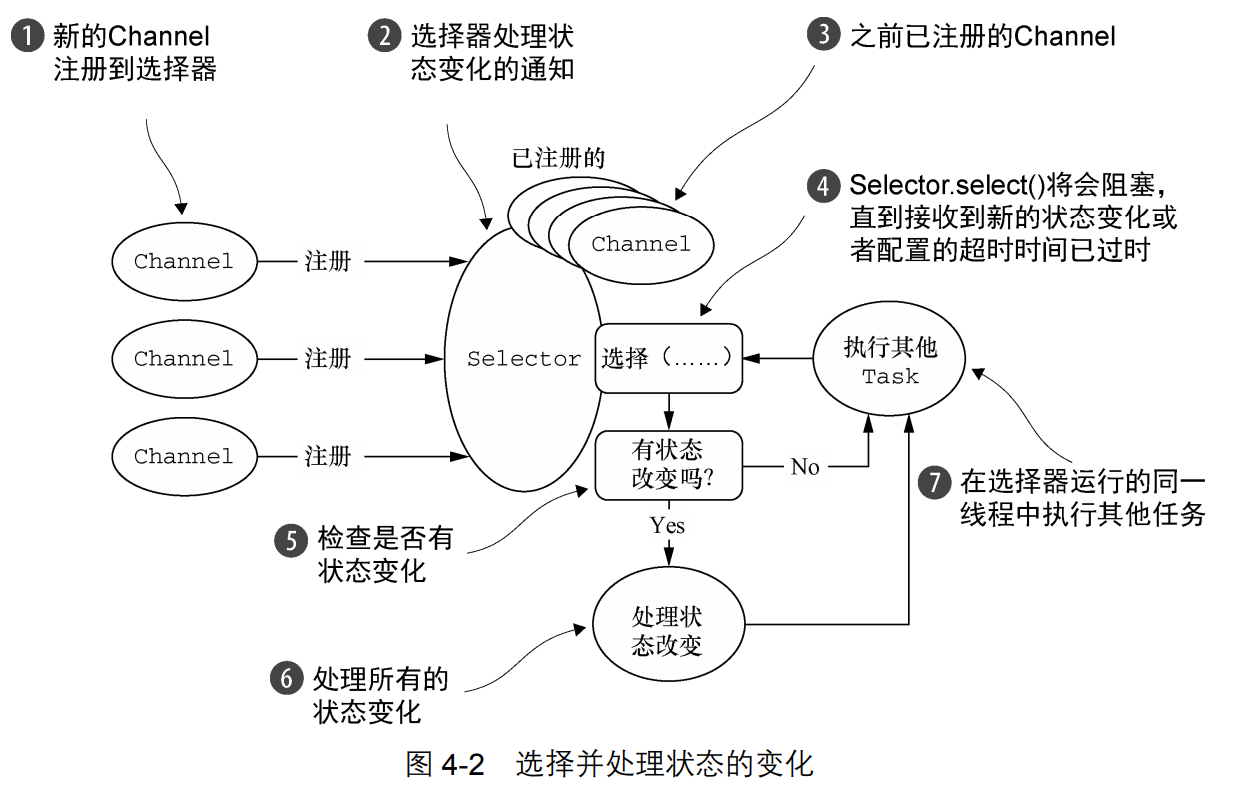
运行结果
服务端
Server on port: 8080 Accepted connection from:Socket[addr=/127.0.0.1,port=8899,localport=8080] Echoing : howdy 0 Echoing : howdy 1 Echoing : howdy 2 Echoing : howdy 3 Echoing : howdy 4 Echoing : howdy 5 Echoing : howdy 6 Echoing : howdy 7 Echoing : howdy 8 Echoing : howdy 9 Echoing : END
客户端
howdy 0 howdy 1 howdy 2 howdy 3 howdy 4 howdy 5 howdy 6 howdy 7 howdy 8 howdy 9 END
2.核心类分析
(1)通道(SelectableChannel)
通道Channel继承体系如下,其中ServerSocketChannel和SocketChannel都继承自SelectableChannel。
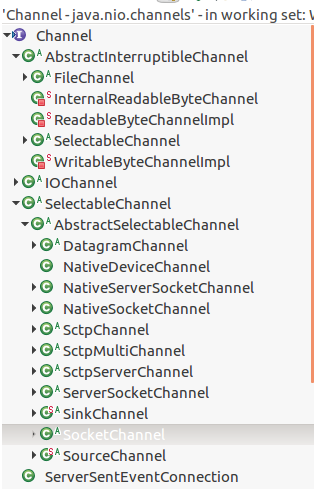
- SelectableChannel通道可以通过Selector实现多路复用(multiplexed)。
- 通道通过register(Selector,int,Object)方法注册到Selector中,并返回SelectorKey(代表注册到Selector上的注册信息)。
- 在一个Selector中,同一个通道只能注册一份;是否可以注册到多个Selector中,由程序调用isRegistered()方法决定。
- SelectableChannel通道是线程安全的。
- SelectableChannel包含阻塞和非阻塞两种模式,只有非阻塞时才可以注册到Selector中。
ServerSocketChannel(A selectable channel for stream-oriented listening sockets.),用于监听Socket的基于流的可选通道。
SocketChannel(A selectable channel for stream-oriented connecting sockets.),用于连接Socket的基于流额可选通道。
(2)选择器(Selector)
Selector是SelectableChannel的多路复选器,该类包含以下方法。
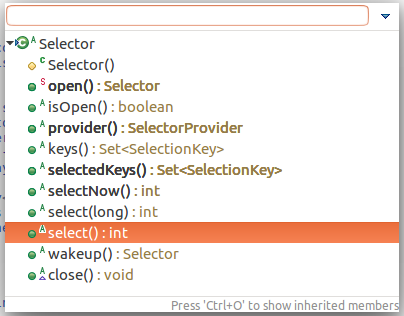
- 通过open()方法创建Selector
- 包含三种SelectorKey Set:所有注册的SelectorKey、被选的SelectorKey(通道发生事件)、被取消的SelectorKey(不可直接访问)
- 每次select()操作,都会从被选的SelectorKey集合中删除或新增,清楚被取消的SelectorKey中的SelectorKey
(3)选择建(SelectorKey)
选择键封装了特定的通道与特定的选择器的注册关系。选择键对象被SelectableChannel.register()返回并提供一个表示这种注册关系的标记。选择键包含了两个比特集(以整数的形式进行编码),指示了该注册关系所关心的通道操作,以及通道已经准备好的操作。包括读、写、连接和接收操作,如下:
public static final int OP_READ = 1 << 0; public static final int OP_WRITE = 1 << 2; public static final int OP_CONNECT = 1 << 3; public static final int OP_ACCEPT = 1 << 4;
3.Reactor设计模式
基于Selector的多路复用IO,机制是采用Reactor设计模式,将一个或多个客户的服务请求分离(demultiplex)和事件分发器 (dispatch)给应用程序(I/O模型之三:两种高性能 I/O 设计模式 Reactor 和 Proactor),即通过Selector阻塞等待事件发生,然后再分发给相应的处理器接口。详情可以参考该篇文章或更多的资料。
摘自链接文章中的一幅图如下:
- Reactor是调度中心,包含select()阻塞,等待事件发生,并分发不同的业务处理。
- 客户端请求连接时,select()接收到事件后,会调acceptor,创建连接并与客户端交互。
- 客户端写数据给服务端时,select()接收到事件后,调read操作,读取客户端数据,可以采用线程池对与客户端交互,对数据进行处理。
- 服务端可也以发生数据给客户端。
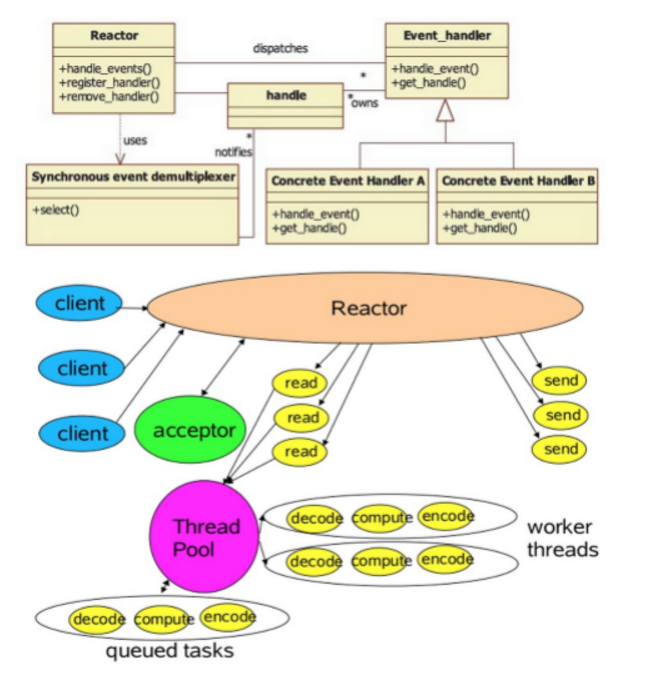
4.总结
1. SelectableChannel(ServerSocketChannel和SocketChannel)可以注册到Selector中,并用选择键(SelectorKey)进行分装
2. SelectorKey中包含选择器感兴趣的事件(读、写、连接和接收)
3. Selector中select()方法阻塞,直到注册通道有事件发生,可以一个线程监控多个客户端,实现多路复用
4. 基于Selector的多路复用采用Reactor设计模式,使得选择器与业务处理进行分离。
5. Netty是异步基于事件的应用框架,其实现是基于Java NIO的,并对其进行了优化,可以进一步学习。
5. 参考
《Thinking in Enterprise Java》